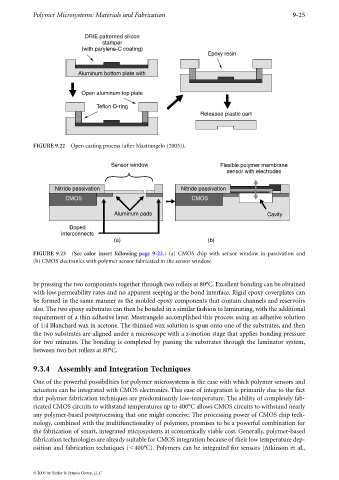Page 504 -
P. 504
Polymer Microsystems: Materials and Fabrication 9-25
DRIE patterned silicon
stamper
(with parylene-C coating)
Epoxy resin
Aluminum bottom plate with
Open aluminum top plate
Teflon O-ring
Released plastic part
FIGURE 9.22 Open casting process (after Mastrangelo (2003)).
Sensor window Flexible polymer membrane
sensor with electrodes
Nitride passivation Nitride passivation
CMOS CMOS
Aluminum pads Cavity
Doped
interconnects
(a) (b)
FIGURE 9.23 (See color insert following page 9-22.) (a) CMOS chip with sensor window in passivation and
(b) CMOS electronics with polymer sensor fabricated in the sensor window.
by pressing the two components together through two rollers at 80°C. Excellent bonding can be obtained
with low permeability rates and no apparent seeping at the bond interface. Rigid epoxy coverplates can
be formed in the same manner as the molded epoxy components that contain channels and reservoirs
also. The two epoxy substrates can then be bonded in a similar fashion to laminating, with the additional
requirement of a thin adhesive layer. Mastrangelo accomplished this process using an adhesive solution
of 1:4 Blanchard wax in acetone. The thinned wax solution is spun onto one of the substrates, and then
the two substrates are aligned under a microscope with a z-motion stage that applies bonding pressure
for two minutes. The bonding is completed by passing the substrates through the laminator system,
between two hot rollers at 80°C.
9.3.4 Assembly and Integration Techniques
One of the powerful possibilities for polymer microsystems is the ease with which polymer sensors and
actuators can be integrated with CMOS electronics. This ease of integration is primarily due to the fact
that polymer fabrication techniques are predominantly low-temperature. The ability of completely fab-
ricated CMOS circuits to withstand temperatures up to 400°C allows CMOS circuits to withstand nearly
any polymer-based postprocessing that one might conceive. The processing power of CMOS chip tech-
nology, combined with the multifunctionality of polymers, promises to be a powerful combination for
the fabrication of smart, integrated microsystems at economically viable cost. Generally, polymer-based
fabrication technologies are already suitable for CMOS integration because of their low temperature dep-
osition and fabrication techniques ( 400°C). Polymers can be integrated for sensors [Atkinson et al.,
© 2006 by Taylor & Francis Group, LLC

